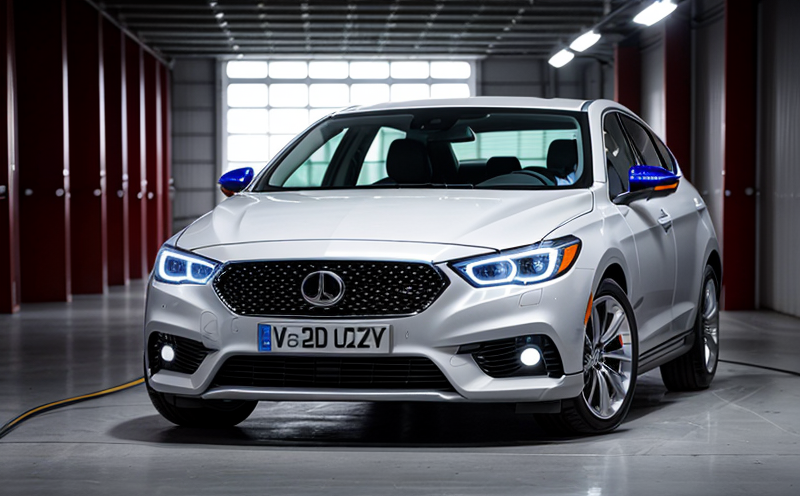Automotive Lighting Testing
The automotive lighting sector is a critical component in ensuring road safety and compliance with international regulations. Automotive lights play a pivotal role in providing visibility to drivers, pedestrians, cyclists, and other vehicles, especially under varying environmental conditions such as night driving or adverse weather. Proper testing of these components ensures not only the safety of passengers but also the broader community by preventing accidents caused by malfunctions.
Automotive lighting tests encompass a wide range of parameters including luminous intensity, color temperature, optical distribution, and electrical performance. These tests are conducted on various types of automotive lights such as headlights, taillights, brake lights, indicator lights, and interior lights to ensure they meet the stringent requirements set by regulatory bodies like the European Union's ECE R124 or the United States' FMVSS 108.
The testing process involves several stages. Initially, the lighting components are subjected to environmental stress tests such as temperature cycling and humidity exposure to simulate real-world conditions. Following this, optical performance is evaluated using specialized equipment like photometers and goniophotometers. Electrical checks ensure that the lights function correctly under load and voltage variations.
One of the key challenges in automotive lighting testing lies in maintaining consistency across different production batches. This requires precise calibration of test fixtures and regular verification against international standards such as ISO 6947 for headlamps or SAE J581 for interior lamps. The use of advanced software tools helps automate data collection and analysis, providing real-time feedback on any discrepancies.
To achieve accurate results, the testing environment must closely mimic actual driving conditions. This includes simulating different road surfaces, weather scenarios, and vehicle speeds. The ability to replicate these variables allows manufacturers to identify potential issues early in the development process, thus reducing costly redesigns later on.
Another aspect of automotive lighting testing is ensuring compatibility with existing systems within vehicles. This involves checking for correct signal outputs from control units and verifying that lights align properly with other vehicle features like wipers or fog lamps.
- Competitive Advantage: By investing in comprehensive automotive lighting tests, companies can differentiate themselves by offering safer, more reliable products. These rigorous evaluations also help build brand reputation among consumers who prioritize safety when making purchasing decisions.
- Market Impact: Meeting regulatory requirements through thorough testing not only avoids penalties but also enhances market access to regions with strict standards. Additionally, meeting or exceeding expected levels of performance can lead to increased customer satisfaction and loyalty.
Why It Matters
The importance of automotive lighting cannot be overstated; it directly influences driving safety and comfort. Properly functioning headlights are essential for safe night driving, while brake lights provide critical visual cues that alert other road users to a vehicle's stopping actions.
Non-compliance with lighting standards can lead to significant financial penalties and damage to brand reputation. For instance, failure to meet ECE R124 or FMVSS 108 could result in product recalls or even legal action against manufacturers.
In addition to regulatory compliance, testing helps improve overall vehicle performance by identifying weak points early in the design phase. Continuous improvement based on test results ensures that each new model meets or exceeds current and future standards.
Consumer expectations around lighting quality are rising steadily as technology advances. Customers now demand more than just functional lights; they expect stylish designs that complement the aesthetic of their vehicles. Automotive lighting tests help manufacturers deliver both functionality and style, enhancing customer satisfaction.
The environmental impact of automotive lighting is also becoming increasingly important. Manufacturers are under pressure to reduce energy consumption and improve sustainability through innovative design practices. Testing plays a crucial role in this effort by helping identify ways to minimize power usage without sacrificing performance.
Eurolab Advantages
At Eurolab, we offer unparalleled expertise in automotive lighting testing, leveraging our state-of-the-art facilities and experienced professionals. Our comprehensive approach ensures that every aspect of your product is thoroughly examined to meet or exceed all relevant standards.
We pride ourselves on offering a full-service solution from initial consultation through final report delivery. This includes detailed guidance on necessary preparations for testing, support during the process, and expert interpretation of results.
Our commitment to quality extends beyond just meeting regulatory requirements. We actively contribute to industry advancements by participating in standards development committees and sharing insights gained from our extensive experience.
At Eurolab, we understand that every project is unique. That's why we tailor each testing program specifically for your needs, ensuring that you receive the most relevant and actionable information possible.





